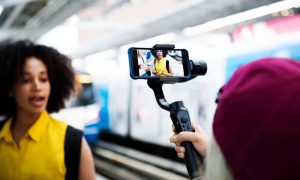One of the ‘hottest’ areas of digital marketing these days involves the use of influencers, who are great for building boost sales and building awareness. These influencers have what you often do not, which is a built-in audience of tens of thousands (sometimes even hundreds of thousands) followers and fans.
Influencer marketing is the new practice that businesses exercise of paying individuals that have a large social following to promote a product or service.
According to a study in April 2017, total brand spending on influencer marketing was $81 billion in 2016. It is projected that that amount will increase to $101 billion by 2020. According to the study, roughly 75% of respondents are already currently using influencer marketing. 43% of that percentage are planning on increasing their influencer marketing within the next year. In the study, they also found out that 27% are planning to start using influencer marketing within the next twelve months.
With just a single Instagram post or a single tweet, you can activate huge audiences to act. People seeing other users they follow using your products or advertising your products has a high chance of convincing them to buy your product. It is basically an intensified version of the more traditional word-of-mouth marketing.


Though influencer marketing has had its fair share of profitable examples, similar to other things on the internet, it also can have major risks. New forms of advertising are sure to bring new issues that previously were not seen. With influencer marketing, one of the biggest risks is hiring and paying influencers that have built a large, but mostly fake, following.
A study by Points North Group of the social influence found lots of big companies that had influencers with a lot of fake followers. Procter & Gamble Co.’s social influence found that 19% of Olay and 32% of Pampers’ paid influencers followers were fake. The highest on that list was Ritz-Carlton, that had influences with 78% fake followers. Marketers believe that roughly ten to fifty percent of their ad spending gets lost to this type of fraud.
Another major risk that companies face is collaborating with an influencer whose actions do not align with those of your brand. One of the biggest recent incidents involved the popular creator, PewDiePie, who lost a lucrative contract with Disney. After Felix Kjellberg (real name of PewDiePie) posted anti-Semitic content along with repeated references to Nazis in his posted content. Shortly after that, Kjellberg also lost a major deal with YouTube Red, YouTube’s subscription-based service.
Though these samples are from larger companies, the same problems can hit a smaller company. All it takes is one bad move from the influencer to tarnish the reputation of the company – even if the company isn’t behind the same views as the influencer.
There are now FCC requirements that any paid influencer must disclose their advertorial relationship with any brand that they are currently promoting. There are a few practices that can help your business to be aware of any risks and how to avoid them.
Top Influencer Marketing Risk Mitigation Strategies
1. Be Wary of Bots or Fake Followers
While many marketers work with influencer marketing partner to find creators that would suit their campaigns, marketers should take the initiative to ask their partners how to validate their fake followers or bots.
Instead of waiting for your campaign to not do as well as you had hoped because of the actual reach of an influencer, you can use tools to scan through influencers. Tools, such as Instascreener, can help businesses spot influencers with large fake followings before you have to pay the influencer for their work.
2. Balance Programs with a Larger Creator Roster
The key to risk mitigation is diversification. Just like for anything else, it’s recommended that you don’t put all your eggs in one basket, as that is a very high-risk move. If you face any major setbacks, by having a roster of creators, you can easily swap one for another.
Another benefit of having a large creator roster is that the budget is almost the same if you were to use one mega creator. Depending on the size of your business and/or your marketing budgets, marketers can work more effectively with a selection of mid-level creators.
3. Collaborative Content Creation
Many marketers continue to believe that the hard part is finding an influencer to work with. But, campaigns should have a few creators working together to review the marketing brief. It should be approved, scheduled, and go live exactly as planned. With all the right approvals, the marketing campaign goes off smoothly without any hiccups if creators were to work completely individually.
For this to be successful, the business should have an individual from your team completely dedicated to helping the hired influencers do the job in a timely manner to your standards.
4. Measure the Impact of Collaborative Creations


Depending on what you want to achieve, you should work towards that with all of your campaigns, including influencer campaigns. For example, Ikea launched a #paid campaign with a few influencers. Their main goal was to increase and maximize the number of clicks to their online catalogs. To achieve this, they created a call-to-action on every post and linked in bios of creators. They used Instagram Story ‘swipe ups’ and bosting through Instagram advertising features.
These clear calls to action help to measure impacts that the campaign made to their online catalog traffic. It also further helps to make a case of expanding budgets for such campaigns in the future or to try a different way to maximize the ROI.
5. Abide Mandatory Disclosure Rules
It is no longer just a recommendation to disclose the material connection between a social media creator and a brand, it’s now a law. This means that both nonmonetary exchanges and monetary agreements, like paid trips or free products, should be disclosed.
Compliance can include things as simple as #paid, #sponsored, #ad, or #spon. But they can also be communicated in natural conversation in the description or spoken. To learn more about the importance of disclosure, transparency, and authenticity with influencer marketing, read through the Disclosure Guidelines for Influencer Marketing in the USA. Keep in mind, it might be different for each country so refer to your country’s guidelines on influencer marketing.
These days, it can often be difficult to see and tell what you will be getting for your money. So, measuring becomes more important than ever. Having clear and organized data from before your collaboration, during and after, allows you to truly see a trend. Ensuring that your chosen influencer has the right market and audience for your business can make or break your campaign.
Influencer marketing has the capacity to work great wonders for small businesses, but it needs to be done with alignment and less cynically. Find out who influences your target audience, then create a marketing strategy to work towards them.
The Atlanta Small Business Network, from start-up to success, we are your go-to resource for small business news, expert advice, information, and event coverage.


While you’re here, don’t forget to subscribe to our email newsletter for all the latest business news know-how from Atlanta Small Business Network.






